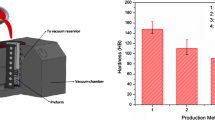Abstract
A preform consisting of a reinforcement and a small proportion of a binder is infiltrated with a liquid metal in order to form a metal-matrix composite. This paper (Part II) reports on the preparation and characterization of preforms of SiC whiskers and of short carbon fibres. Both types of preform were prepared by wet forming, using either a silica binder or an acid phosphate binder (with the P/Al atom ratio ranging from 1–23), and using either water or acetone as the liquid carrier during wet forming. The dependence of the compressive strength of the preform on the binder species, binder quantity and preform heat-treatment temperature (up to 1200 °C) and atmosphere (air or argon) is presented. For SiC whisker preforms made by using an acid phosphate binder containing excess phosphoric acid, the binder-SiC reaction product, SiP2O7, was primarily responsible for increasing the compressive strength of the preform. The SiC whisker preforms made by using the phosphate binders generally had higher compressive strengths than those of preforms made by using the silica binder after heat treatment at 500 °C or above. The compressive failure of the SiC whisker preforms made with the phosphate binders was in shear, whereas the failure of the SiC whisker preforms made by using the silica binder involved lateral surface buckling. This difference is due to the more uniform binder distribution in preforms made with the phosphate binders. Thus, preforms made with the phosphate binders have better machinability and are stronger. The determining parameters for the compressive strength of the SiC whisker preforms are the relative amount of the binder and the relative reactivity between the SiC whiskers and the binder. The crystallinity, phase and morphology of the binders showed little effects. The relative reactivity increased with increasing temperature if the binder and heating environment were fixed. The relative reactivity increased with increasing P/Al atom ratio. In the SiC whisker preforms made with different phosphate binders after heat treatment at the same temperature, the relative amount of the binder played a more important role than the relative reactivity.
Similar content being viewed by others
References
Jeng-Maw CHIOU and D. D. L. CHUNG, J. Mater. Sci. 28 (1993) 1135.
Idem, ibid. 28 (1993) 1471.
M. TSUHAKO, Kagakuno Ryoiki 37 (1983) 194.
M. J. O'HARA, J. J. DUGA and H. D. SHEETS Jr, Ceram. Bull. 51 (1972) 590.
W. D. KINGERY, J. Amer. Ceram. Soc. 33(8) (1950) 239.
W. R. BECK, ibid. 32(4) (1949) 147.
Author information
Authors and Affiliations
Rights and permissions
About this article
Cite this article
Chiou, J.M., Chung, D.D.L. Improvement of the temperature resistance of aluminium-matrix composites using an acid phosphate binder. Journal of Materials Science 28, 1447–1470 (1993). https://doi.org/10.1007/BF00363336
Received:
Accepted:
Published:
Issue Date:
DOI: https://doi.org/10.1007/BF00363336




